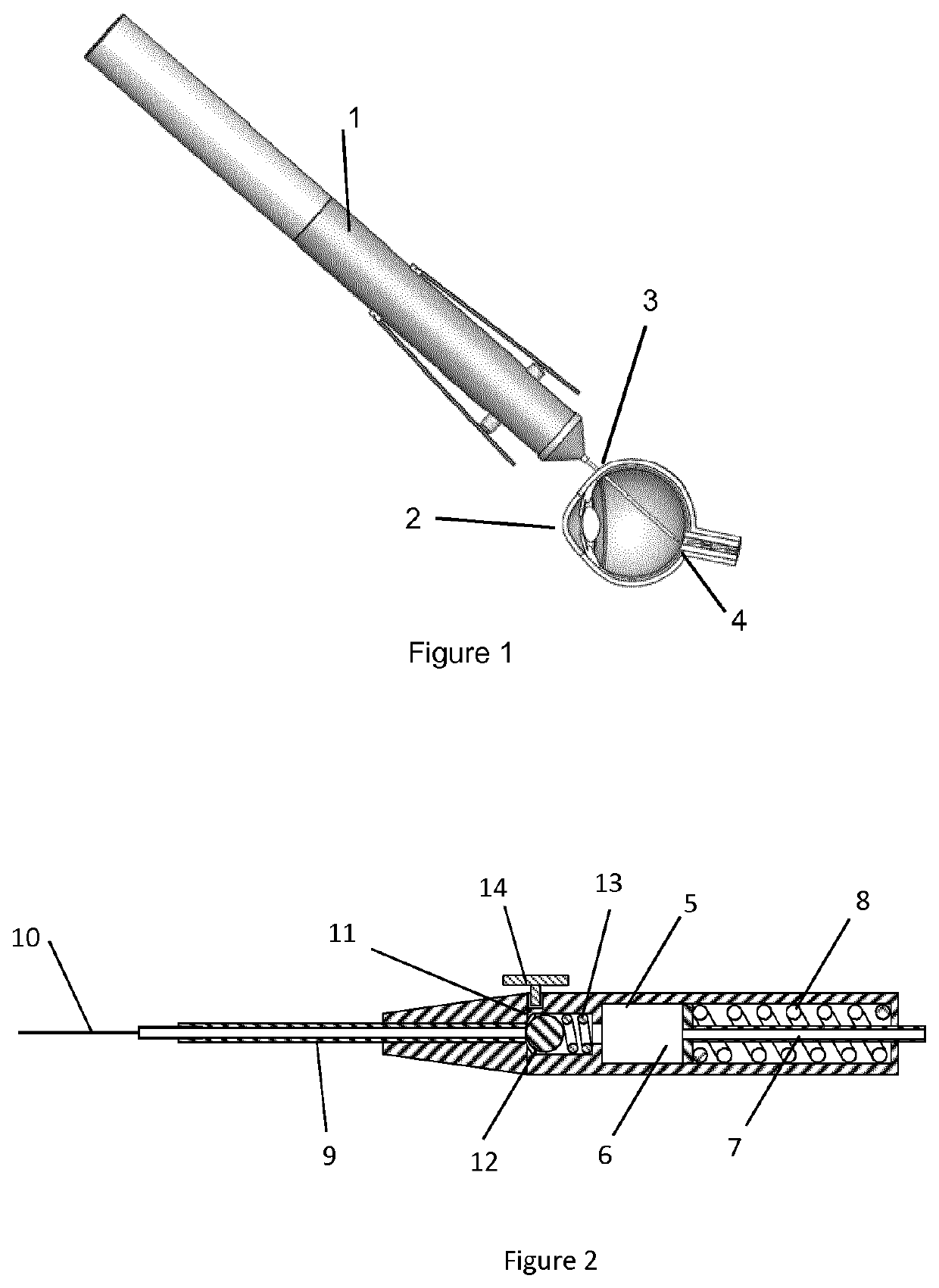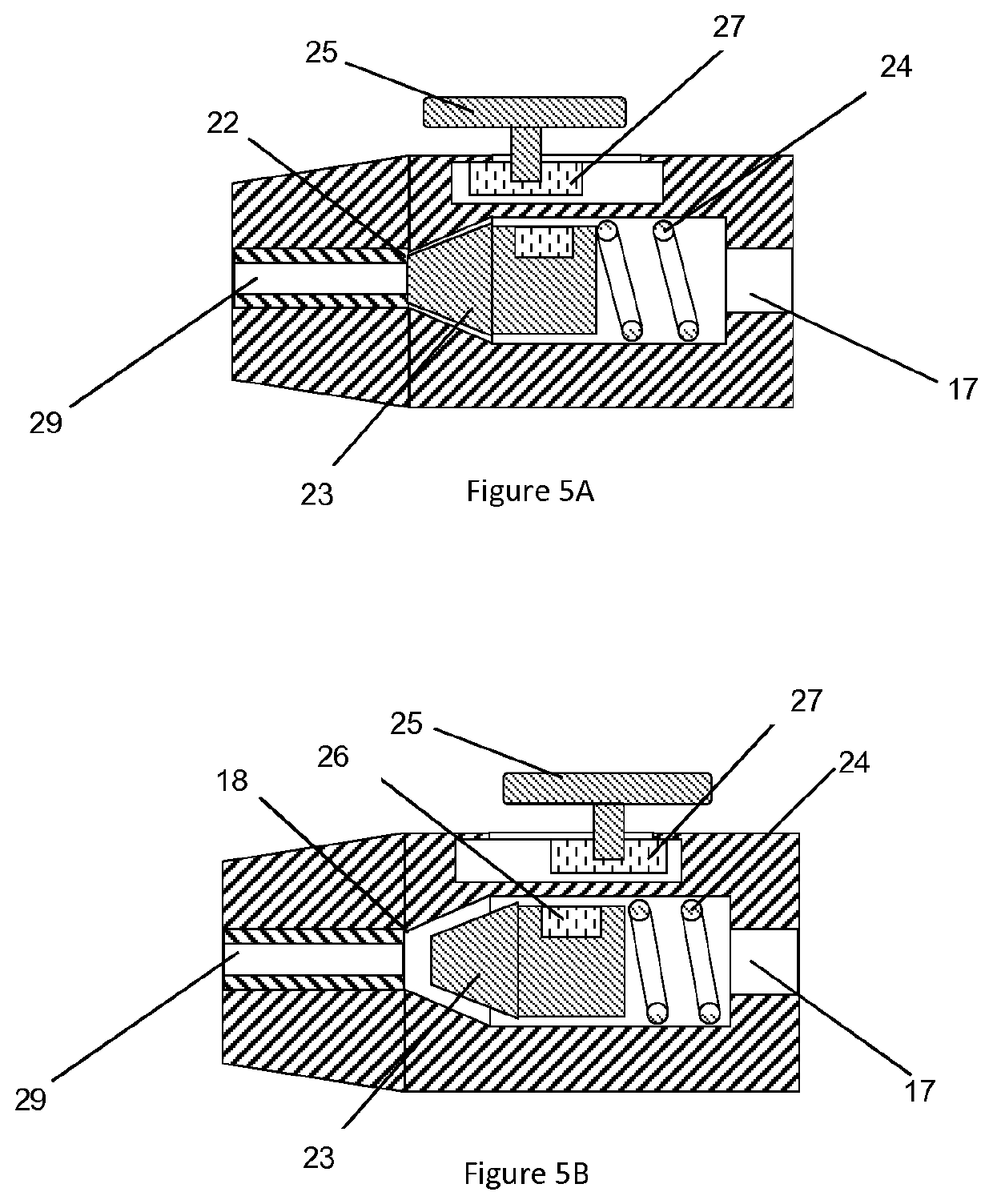Ophthalmic injection device
a technology of ophthalmic injection and ophthalmic nerve, which is applied in the direction of eye treatment, process and machine control, etc., can solve the problems of undetected permanent detachment of the retina, inability to achieve significant therapeutic concentrations in the posterior portion of the eye and the retina with topical administration methods, etc., to achieve high-controlled delivery of therapeutic agents, prevent leakage of injected material, and minimize trauma to sensitive ocular tissues
- Summary
- Abstract
- Description
- Claims
- Application Information
AI Technical Summary
Benefits of technology
Problems solved by technology
Method used
Image
Examples
example 1
on of One Embodiment of an Injection Device
[0073]The device according to one embodiment similar to the device shown in FIG. 2 was fabricated. A valve body 14.75 mm long was molded from silicone rubber of durometer 50 Shore A (Nusil, Part No. MED-4950) which comprises a proximal valve chamber of 3.43 mm diameter and 6.5 mm depth, dimensioned to accept a 3.175 mm diameter stainless steel spherical ball acting as a valve sealing element and a valve compression spring of 3.175 mm diameter and 8.26 mm long fabricated from 0.3 mm diameter wire. The valve body incorporated a valve seat of 1.91 mm diameter and 2.35 mm depth distal to the chamber, configured such that the ball acting as the valve sealing element was compressed against the valve seat by the valve spring. The molded valve body incorporated a compression flange 9.25 mm diameter and 1.25 mm thick on the proximal end. The distal end of the valve body was configured with a lumen to accept a 23 gauge tube that was press fit into th...
example 2
[0079]A device according to Example 1 was fabricated. De-ionized water as the injection material was drawn up into a 1 ml syringe and the syringe was attached to the Luer fitting of the plunger check valve. Approximately 0.3 ml of water was filled into the reservoir causing the plunger to retract proximally and compressing the plunger spring thereby providing a force on the injection material in the device reservoir. No injection material flowed out of the distal cannula. The actuation button was depressed and water was seen flowing out of the distal cannula. The actuation button was released and the fluid flow stopped. The action was repeated with the same results.
example 3
f Injection Device in an Eye
[0080]A device according to Example 1 was fabricated. A porcine cadaver eye was prepared for using the device for a subretinal injection. The procedure was performed under a stereo microscope for ease of visualization. In order to access the retina in the cadaver eye, the cornea was completely removed at the limbus. The natural lens was carefully excised by cutting the zonular fibers away from the lens then lifting the lens out of the globe. The vitreous was removed en-masse leaving the retina behind. The device was loaded with 0.2 ml of 0.1% fluorescein solution using a 1 ml syringe filled with the fluorescein solution attached to the plunger check valve. The distal cannula was carefully inserted through the retina tissues and was advanced. The cannula deflected across the choroidal surface, traversing a short distance parallel to the tissues.
[0081]The actuation button was depressed for approximately 1.5 seconds during which time fluorescein solution cou...
PUM
 Login to View More
Login to View More Abstract
Description
Claims
Application Information
 Login to View More
Login to View More - R&D
- Intellectual Property
- Life Sciences
- Materials
- Tech Scout
- Unparalleled Data Quality
- Higher Quality Content
- 60% Fewer Hallucinations
Browse by: Latest US Patents, China's latest patents, Technical Efficacy Thesaurus, Application Domain, Technology Topic, Popular Technical Reports.
© 2025 PatSnap. All rights reserved.Legal|Privacy policy|Modern Slavery Act Transparency Statement|Sitemap|About US| Contact US: help@patsnap.com



